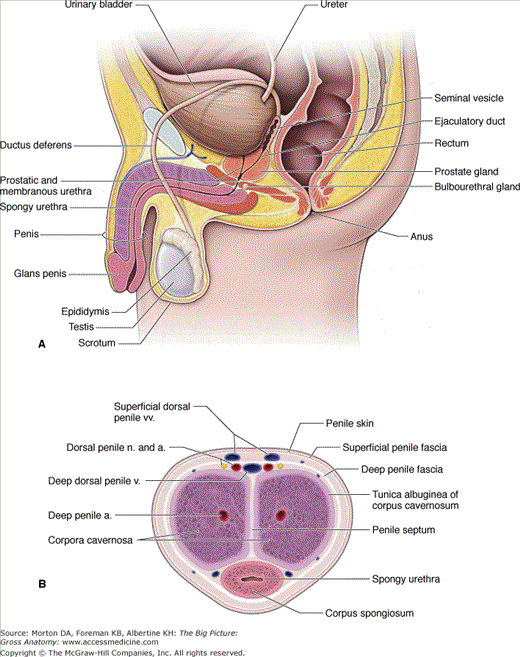Male Reproductive System
The male reproductive system primarily consists of the paired testes and the penis. In addition, accessory sex glands contribute to seminal fluid. The male reproductive system matures during adolescence and remains active for the remainder of the lifespan of the male.
The following genital organs and glands comprise the male reproductive system (Figure 13-1A):
- Testes. The primary male sex organ. The testes produce sperm and sex hormones (e.g., testosterone) and are located within the scrotum.
- Epididymis. A convoluted duct that sits on the superior pole of each testis. Sperm are stored in the epididymis during the maturation process.
- Ductus deferens. A thick-walled tube in the spermatic cord that transports sperm from the epididymis to the ejaculatory ducts in the prostate gland. The ductus deferens traverses the superficial inguinal ring, coursing through the inguinal canal, and enters the pelvis through the deep inguinal ring lateral to the inferior epigastric artery. En route to the ejaculatory duct, the ductus deferens crosses the medial side of the umbilical artery and the obturator neurovascular structures. Sympathetic nerves from the inferior hypogastric plexus cause peristaltic contractions in the thick smooth muscle wall and propel sperm during ejaculation.
- Ejaculatory ducts. Formed by the union of the ductus deferens and ducts from the seminal vesicles. The ejaculatory ducts open into the prostatic urethra.
- Seminal vesicles. Lobular glands located on the base of the bladder. During emission and ejaculation, the seminal vesicles empty their secretions (e.g., fructose, citric acid, prostaglandins, and fibrinogen) into the ejaculatory duct, along with sperm from the ductus deferens. Seminal vesicle secretions add substantially to the volume of semen.
- Prostate gland. Composed of five lobes, all surrounding the prostatic urethra. The prostate gland is located superior to the pelvic diaphragm and anterior to the rectum. The prostate gland secretes a milky fluid that contributes to the bulk of the semen.
 The prostate gland may hypertrophy as men age. As a result of an enlarged prostate gland, affected men may have difficulty urinating because the gland surrounds the urethra. Because of its proximal anterior location to the rectum, the prostate gland is relatively easy to palpate. A digital rectal examination is performed to determine the size of the prostate gland. During a digital rectal examination, the physician may also palpate the seminal vesicles and the ductus deferens.
The prostate gland may hypertrophy as men age. As a result of an enlarged prostate gland, affected men may have difficulty urinating because the gland surrounds the urethra. Because of its proximal anterior location to the rectum, the prostate gland is relatively easy to palpate. A digital rectal examination is performed to determine the size of the prostate gland. During a digital rectal examination, the physician may also palpate the seminal vesicles and the ductus deferens.
The deep perineal space (pouch) is the region within the urogenital diaphragm (Figure 13-1D
Stay updated, free articles. Join our Telegram channel

Full access? Get Clinical Tree




